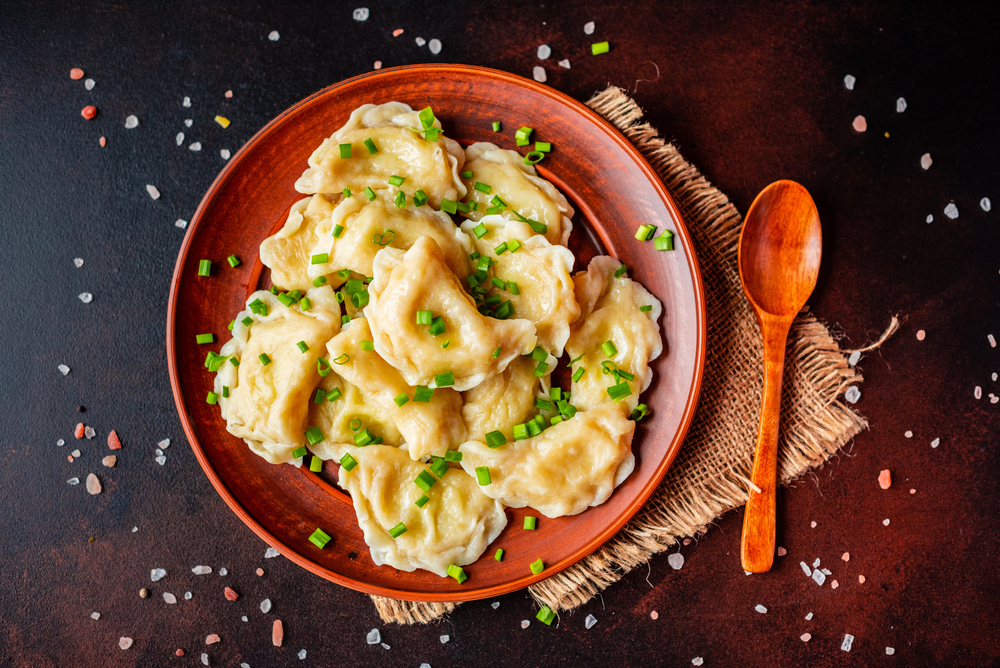Few dishes evoke the comforting spirit of Polish cuisine quite like pierogi. These delightful dumplings, with their simple dough and seemingly endless filling possibilities, represent a culinary tradition passed down through generations. They’re more than just food; they’re a symbol of home, family, and celebration.
What are Pierogi?
Pierogi are traditional Polish dumplings crafted from unleavened dough, typically filled with a variety of ingredients such as mashed potatoes, cheese, meat, or fruit. These delightful parcels are usually boiled and then pan-fried or baked to achieve a perfect balance of textures. Often served with an array of toppings and sauces, pierogi have a long-standing history in Polish cuisine and are a staple in many Eastern European countries.
Whether enjoyed as a main course, side dish, or even dessert, pierogi are a beloved comfort food around the world. Their versatility and rich cultural heritage make them a cherished dish that brings people together, offering a taste of tradition in every bite.
Delving into the Delicious World of Potato and Onion Pierogi
While pierogi can be filled with a vast array of ingredients, from savory meats to sweet fruits, this post will focus on a classic and beloved combination: potato and onion. This filling offers a creamy, savory, and subtly sweet flavor profile that is both satisfying and incredibly versatile.
A Classic Recipe for Potato and Onion Pierogi
Let’s explore how to create these culinary treasures in your own kitchen. This recipe provides a foundation, and feel free to adjust it to your own preferences as you become more comfortable with the process.
Ingredients
For the Dough:
- 3 cups all-purpose flour
- In a medium bowl, combine the flour and salt.
- 1 teaspoon salt
- 2 tablespoons butter, softened
- ⅔ cup water
For the Filling:
- 1 (7.6 ounce) package instant mashed potato flakes (or equivalent amount of homemade mashed potatoes)
- 1 tablespoon olive oil
- 1 small onion, finely diced
- 3 tablespoons butter
- 1 teaspoon salt
- ⅓ cup sour cream (optional, but adds richness)
Instructions: Crafting the Perfect Pierogi
Making the Dough:
- In a large bowl, combine the flour and salt.
- Cut in the softened butter using a pastry blender or your fingers until the mixture resembles coarse crumbs.
- Gradually add the water, mixing until a dough forms. If the dough seems too dry, add a little more water, a teaspoon at a time. If it is too sticky, add a sprinkle of flour.
- Turn the dough out onto a lightly floured surface and knead for 2-3 minutes until smooth and elastic.
- Cover the dough with plastic wrap or a clean kitchen towel and let it rest for at least 10-15 minutes. This allows the gluten to relax, making the dough easier to roll.
Preparing the Filling:
- Prepare the mashed potatoes according to the package directions (if using instant) or use your favorite homemade mashed potato recipe. Aim for a relatively stiff consistency, not too loose.
- Heat the olive oil in a skillet over medium heat.
- Add the diced onion and cook, stirring frequently, until softened and translucent, about 5-7 minutes.
- Remove the skillet from the heat and stir in the mashed potatoes, butter, and salt. If using, incorporate the sour cream until evenly combined. Add the remaining butter to the skillet and allow it to melt, creating a rich sauce.
- Taste and adjust seasoning as needed. You might want to add a pinch of black pepper or other spices.
Assembling the Pierogi:
- Divide the rested dough in half. Keep one half dough covered while you work with the other.
- On a lightly floured surface, roll out the dough to approximately 1/8 inch thickness.
- Use a round biscuit cutter (about 3 inches in diameter) or a glass to cut out circles of dough.
- Place a rounded tablespoon of the potato and onion filling in the center of each dough circle.
- Carefully fold the dough over to form a half-moon shape.
- Pinch the edges firmly together to seal, ensuring no filling leaks out. You can use a fork to crimp the edges for a decorative touch and a more secure seal.
- Repeat with re-rolled scraps of dough and other half of dough ball.
Cooking the Pierogi:
- Bring a large pot of salted water to a boil.
- Carefully drop the pierogi into the boiling water, working in batches to avoid overcrowding the pot.
- Cook for about 3-5 minutes, or until the pierogi float to the surface and are cooked through.
- Remove the pierogi with a slotted spoon and place them on a plate.
For flash-freezing, place the pierogi on a baking sheet in a single layer and freeze until solid before transferring to a freezer bag.
Optional: Pan-Frying:
For an extra layer of flavor and texture, you can pan-fry the boiled pierogi. Melt some butter in a skillet over medium heat. Add the pierogi and cook until golden brown and slightly crispy on both sides.
Exploring Filling Variations: Beyond the Basics with Caramelized Onions
The beauty of pierogi lies in their adaptability. While potato and onion is a classic, feel free to experiment with different ingredients:
- Cheeses: Add shredded cheddar, farmer’s cheese, or even a sprinkle of Parmesan to the potato mixture for extra richness.
- Herbs: Fresh chives, dill, or parsley add a burst of freshness to the filling.
- Spices: A pinch of garlic powder, onion powder, or smoked paprika can enhance the savory notes.
- Different Potatoes: Use Yukon Gold potatoes for a buttery flavor, or Russets for a fluffier texture. Sweet potatoes are also a very popular filling option.
- Different Onions: Try using sweet onions, like Vidalia, for a milder flavor, or red onions for a bit of color and bite.
The History and Cultural Significance of Pierogi
Pierogi are not merely a delicious meal; they hold a special place in Polish history and culture. While their precise origins are debated, they are believed to have roots in Central or Eastern Europe. A popular legend credits Saint Hyacinth, a 13th-century Polish Dominican friar, with bringing pierogi to Poland. It’s said he fed them to the poor in Kraków after a Tatar invasion, earning him the affectionate title of “Saint Hyacinth with Pierogi.”
Pierogi are a staple food during important Polish holidays, especially Christmas Eve (Wigilia) and Easter. Different fillings are often associated with specific occasions, such as sauerkraut and mushroom pierogi for Christmas Eve, and sweet cheese pierogi for Easter. They are also a common feature at weddings and other family gatherings.
Toppings and Sauces: Elevating the Pierogi Experience
Pierogi can be elevated to a whole new level with the right toppings and sauces. Here are some classic and creative options to try:
- Sour Cream: A classic topping for pierogi, sour cream adds a tangy and creamy element to the dish.
- Caramelized Onions: Slow-cooked caramelized onions bring a sweet and savory flavor that complements the pierogi perfectly.
- Sautéed Onions: Quickly sautéed onions add a crispy texture and a burst of flavor to pierogi.
- Cheddar Cheese: A sprinkle of cheddar cheese introduces a rich and creamy element, enhancing the overall taste.
- Butter Sauce: A simple butter sauce made with melted butter and flour adds a rich and creamy touch to pierogi.
- Fresh Thyme: A sprinkle of fresh thyme provides a bright and herbaceous flavor, adding a fresh note to the dish.
- Apple Cider: A drizzle of apple cider offers a sweet and tangy flavor, creating a unique twist on traditional pierogi.
- Olive Oil: A drizzle of olive oil adds a rich and savory flavor, enhancing the overall taste profile.
These toppings and sauces can be used individually or in combination to create a unique and delicious pierogi experience. Experiment with different combinations to find your favorite!
Serving Suggestions: Completing the Pierogi Experience with Sour Cream
The classic way to serve potato and onion pierogi is with a dollop of sour cream and a sprinkle of caramelized onions. Other popular toppings include:
- Melted butter
- Crispy fried bacon bits
- Chopped fresh chives or dill
- A simple sauce, such as a mushroom gravy.
Pierogi also freeze exceptionally well, both before and after cooking. This makes them a convenient option for meal prepping or having a quick and delicious meal on hand. For a quick meal, you can also use pre-made frozen pierogies, which are available in most grocery stores and can be cooked directly from frozen.
Pierogi: A Culinary Journey Worth Taking
Pierogi are a testament to the simple elegance of Polish cuisine. The process of making homemade pierogi is a cherished tradition that brings families together, especially during cultural celebrations. They are a dish that connects generations, offering a taste of history and tradition in every bite. Whether you are a seasoned cook or a beginner, making pierogi is a rewarding experience. Embrace the process, experiment with flavors, and share this culinary treasure with your loved ones.
If you’re eager to experience authentic Polish flavors without the effort of making them from scratch, you can buy pierogi online from Polka-Deli.com. We offer a wide selection, crafted with care and tradition.
Beyond Potato and Onion: A World of Pierogi Flavors with Cheddar Cheese.
The world of pierogi fillings extends far beyond the classic potato and onion. The dough acts as a blank canvas. Polka-Deli has many of those flavors on offer, such as:
- Sauerkraut and Mushroom: A tangy and earthy filling, very popular for Christmas Eve. The sauerkraut provides a sour contrast to the savory mushrooms.
- Meat: Often made with ground pork, beef, or a combination, seasoned with herbs and spices.
- Cheese: Farmer’s cheese is a traditional choice, offering a slightly sweet and tangy flavor.
- Potato and Cheese Very similar to potato and onion, the cheese adds another rich texture.
- Spinach: Usually mixed with cheese and garlic. These green pierogi are a great option for a tasty hit of vegetables.
- Fruit: Sweet pierogi are also common, filled with blueberries, strawberries, cherries, or plums. These are often served as a dessert or a sweet main course.
Pierogi Making: Tips and Tricks for Success with Frozen Pierogies
While the basic pierogi recipe is straightforward, there are a few tips that can help ensure success:
- Don’t Overwork the Dough: Over-kneading can make the dough tough. Knead just until it comes together and is smooth.
- Rest the Dough: Allowing the dough to rest lets the gluten relax, making it easier to roll out and preventing it from shrinking.
- Roll Thinly: The dough should be rolled out thinly, but not so thin that it tears easily.
- Seal Well: Make sure the edges of the pierogi are sealed tightly to prevent the filling from leaking out during cooking. Use a fork to crimp the edges for a better seal.
- Don’t Overcrowd the Pot: Boil the pierogi in batches to prevent them from sticking together and to ensure even cooking.
- Test for Doneness: Pierogi are done when they float to the surface and the dough is cooked through.
The Evolution of Pierogi: From Humble Beginnings to Global Cuisine
While pierogi are deeply rooted in Polish tradition, they have also found their way into other cuisines, sometimes with regional variations. Similar dumplings can be found in Ukraine (varenyky), Russia (pelmeni), Slovakia (pirohy), and other Eastern European countries. Each culture has its own unique take on the fillings and serving styles, but the basic concept of a filled dough dumpling remains the same.
In recent years, pierogi have experienced something of a culinary renaissance, with chefs and home cooks experimenting with new and innovative fillings and presentations. From gourmet pierogi with truffle oil and exotic mushrooms to fusion pierogi that blend different culinary traditions, the possibilities are endless.
Preserving Tradition: The Importance of Handmade Pierogi
While commercially made pierogi are readily available, there’s something special about handmade pierogi. The process of making them, often a family affair, is a way of preserving culinary heritage and passing down traditions through generations. The care and attention that goes into each hand-folded dumpling is reflected in the flavor and texture, creating a truly unique culinary experience.
Sharing the Love: Pierogi as a Symbol of Hospitality
In Polish culture, sharing food is an act of generosity and hospitality. Offering pierogi to guests is a way of welcoming them into your home and sharing a part of your heritage. Pierogi often take center stage at gatherings and celebrations, symbolizing togetherness and the joy of sharing a delicious meal with loved ones.
Enjoying the Pierogi Experience to the Fullest
Pierogi are such a versatile dish that no matter if you prefer savory or sweet, served boiled or fried, a snack, main or side, there truly is a Pierogi for everyone and every occasion. Polka Deli is proud to present its pierogi options online. Check out our great selection of pierogi for sale.









